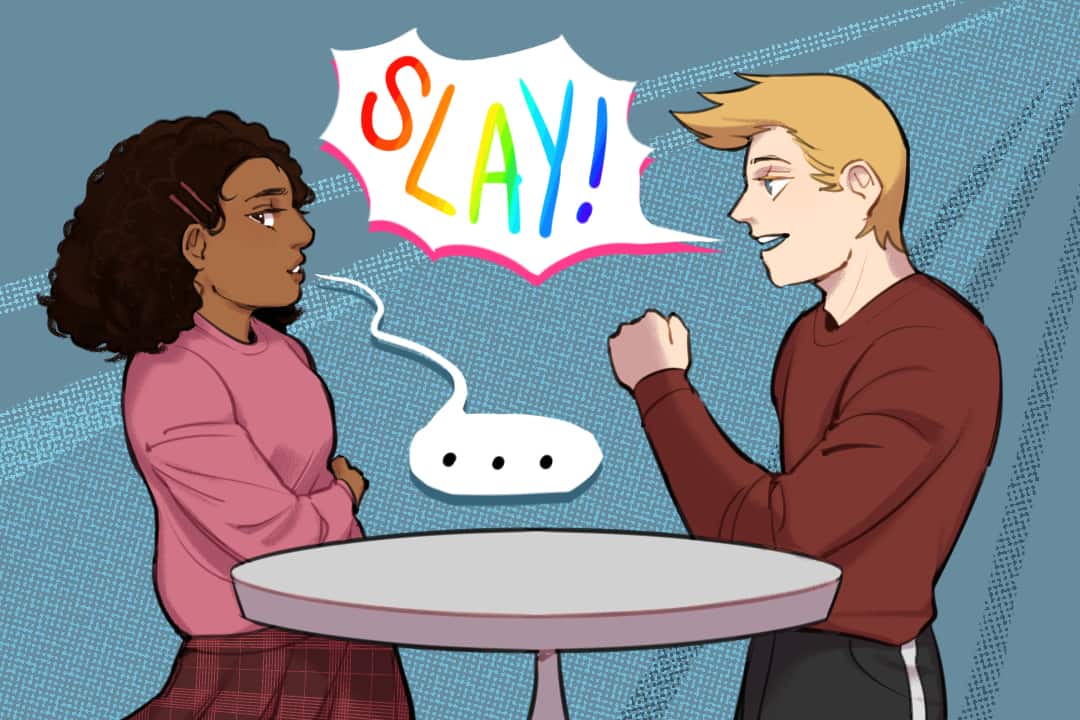One evening, at the beginning of my second year of university, I sat in a cramped, eclectic bar with my first-ever Hinge date. We had already spent a couple of hours chatting, and the ice in our drinks had begun to melt.
“I’m just gonna go to the bathroom. I’ll be right back,” I announced, rising from my chair.
“Okay, slay!” was her response.
‘Slay.’ A word with many meanings and many iterations. At that moment, I experienced it in a new, startling context. This was not the last I would hear of it over the course of the evening, either. As the date progressed, and so did our flirtatious advances, I could not shake that word from our discussion. Slay decorated every one of her sentences. The evening drew to a close and we kissed goodnight. As I waved goodbye, she called out, “Goodnight, queen!”
Slay? Queen? Had this become the novel language of love, and I just hadn’t gotten the memo? The vocab reserved for hyping up your platonic besties seemed to permeate my dating life. I thought this was a one-time occurrence, but she didn’t represent the last of my romantic encounters littered with saccharine, appropriated African American Vernacular English (AAVE).
Many women and men I courted over the following year threw around “slay” and “queen” constantly in what struck me as very nonbestie scenarios. Just my luck. Was I being repeatedly friend zoned or was my experience symptomatic of a greater “slay” oversaturation in society? My increasing frustration with being queen-bombed compelled me to investigate the evolution of the meaning of “slay” and “queen.”
America seems to be a ‘bottom-up’ culture. This means that its cultural trends are largely set by the masses or marginalized classes of the social ladder instead of those with the structural power. Sociolinguists have observed this bottom-up journey of AAVE from Black America to the rest of the world via pop culture and the internet. Words such as “slay” and “queen” come from one American subculture in particular: the American LGBTQ+ ballroom and drag scene.
“Slay” first emerged in the ballroom scene during the ’70s–’80s and first came to prominence in Paris is Burning, a 1990 documentary. The documentary was one of the first and most notable examples of gay men and trans femmes of colour gaining greater media representation. It shines a light on the New York ballroom scene, where LGBTQ+ racialized people competed in flamboyant runways and dance battles while forming a strong community in a world that pushed them to the margins.
Throughout the documentary, members of the community offer their definitions of ballroom jargon, such as “realness” and “shade.” The exposure the ballroom scene received in the documentary exposed their vocabulary to the masses, as did the appropriation of this type of culture by pop stars like Madonna.
However, what truly took LGBTQ+ AAVE from niche queer culture to the vocabulary of straight men I’ve met on dating apps is the phenomenon of RuPaul’s Drag Race. As gay culture gains a wider audience through popular media, the effervescent spunk of a once-underground language becomes irresistible to modern viewers. One study by Christian Ilbury linked the use of these terms in the online vocabulary of white gay men in the UK via drag culture as a way of socially signalling a certain persona, that of a sassy, ‘fierce’ individual. Not to mention the show’s large woman viewership. Over time, LGBTQ+ AAVE words have diffused up the echelons of society. This dialect has made quite the journey.
What will be the fate of “slay” and “queen?” Will they join words like “on fleek” and “lit” in the graveyard of slang once deemed cutting edge? Most people mean no harm when using popularized jargon — even I sometimes find “slay” making an involuntary appearance in my vocabulary. Environments shape the words we use.
However, something sinister can be said about the way the mainstream recycles Black and queer expressions and hollows them of their sincerity. The aforementioned British study by Ilbury observed that the deployment of AAVE in Twitter altercations “reduces the speakers’ commitment to the pragmatic force of their message.” Outside its original context, “queen” tends to sound superficial, an almost patronizing word for girls you’ve just met in a club bathroom or girls you don’t respect but praise with a tinge of irony. And “slay” has recently taken on a blasé din. Who can blame me for bemoaning these words when they’ve been overused and warped into a caricature of their original meaning?
The oversaturation of slay has indeed proven detrimental to the original communities who started it. Straight men mock and look down at girls for their shrill queening and slaying. And queer women like myself agonize over these trendy words for muddling an already marginalized romance. Given how LGBTQ+ AAVE has evolved to connote patronizing irony, you can imagine my horror of hearing it tossed around by love interests. Only in the corners of the city’s ballroom scene can we still witness genuine “queens” or hear “slay” being used with real enthusiasm instead of as an off-hand, catch-all phrase.
To conclude, I need not plead with the masses to stop tossing around “slay” and “queen.” It is not my place to do so and, regardless, the grim reaper of time and our fickle linguistic trend cycle will do the work for me. But please, use another adjective if you think I’m cute.


